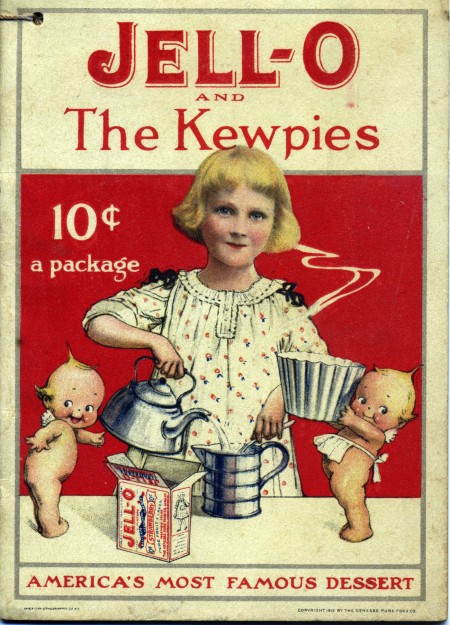Jell-O and the Kewpies. New York: American Lithographic Co., 1915.
When I was twelve years old, we moved from a semi-suburban, overwhelmingly Mormon neighborhood to a neighborhood full of hippies. My Jell-O consumption, already shaken by the disappearance of my beloved Jell-O 1-2-3, took a nosedive. Gone were the block parties and playdates with their lime Jell-O jigglers and pistachio puddings; my mother started buying fruit leather and hummus from the local food co-op instead. Over the last few years, in my own mildly reactionary way, I have found my way back to Jell-O. I now own at least three Jell-O cookbooks and a variety of molds. I even had myself convinced at one point that Bavarian Creams (Jell-O style, of course) were just the thing for summer entertaining.
Jell-O did not worm its way into my heart by accident. Orator Frank Woodward, who bought the rights to Jell-O in 1897, was determined to dominate the American gelatin industry. He proved adept at marketing. In 1902, his company, the Genesee Pure Food Co., advertised Jell-O as “America’s Most Famous Dessert,” long before most Americans had ever heard of it. Catchy slogans were only one part of their plan. They also wrote, and cleverly gave away, colorful pamphlets with recipes for Jell-O. These pamphlets created a demand for Jell-O, as Woodward had hoped. Beginning in 1904, these pamphlets included pictures of the “Jell-O Girl.” Her face was displayed prominently on Jell-O boxes and advertisements, and was meant to differentiate Jell-O from its competitors. In 1908, the Kewpies made their first appearance. They were also used in advertisements, pamphlets, and packaging.
This pamphlet, published in 1915, begins with an earnest introduction of the Kewpies. They are “cheery little imps, who are always doing something to lighten tasks and brighten the dull spots in life, to make the easy Jell-O way still plainer and easier” (emphasis added). Jell-O was selling a lifestyle, not just a dessert. They were also, just to be safe, attacking other desserts: “Twenty years ago everybody ate pie and nearly everybody had dyspepsia…. Now there is scarcely a housewife in America who does not make and serve Jell-O desserts, and stomach-ache is not so common as it used to be.” Jell-O was easily molded *and* cured stomach ailments–a wonder dessert!
And, I admit, the desserts do look pretty wonderful. Marion Harland’s Pineapple Bavarian Cream (ingredients: lemon Jell-O, canned pineapple) and the Delmonico Dessert look great. Even the unadorned Raspberry Jell-O in the lower right looks beautiful. They had nicer molds in 1915.
Jell-O, as it happens, is more than just a pretty dessert. It is also, according to the Kewpies, “good for little folks, sick or well.” And though he goes unnamed, “one of the greatest physicians in America says that he found that by combining nuts and fruits with Jell-O he produced a diet which is both sustainable and delightfully palatable.” I might find an all Jell-O diet “delightfully palatable” for about a day, but I find it hard to believe that anyone would want to go much longer than that.
 The pamphlet comes with a little bonus: a section about Jell-O Ice Cream Powder. The box claims that the powder can be used to make “puddings, ice creams, sherbets, and ices.” Jell-O eventually abandoned the ice cream powder idea, and focused their attentions on pudding. These ice creams, though–tutti frutti, walnut, Neapolitan–look rather exciting.
The pamphlet ends with the Kewpies, this time in strange (military, housewife) costumes, guarding the Jell-O, and a reminder that “the famous Jell-O desserts can not be made of anything sold in any other kind of package.”
Jell-O has published countless pamphlets and recipe books. I recommend Carolyn Wyman’s excellent Jell-O: A Biography for those interested in learning more.






[…] This post was mentioned on Twitter by cookstr and Kim Beeman, Kim Beeman. Kim Beeman said: A new post: Jell-O and the Kewpies! http://bit.ly/imGSl […]
i have july 11 1911 page 50 the delineator magazine framed jell-o i would like to know the artist and value of this historical ad